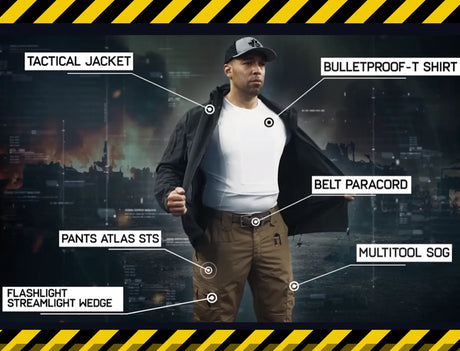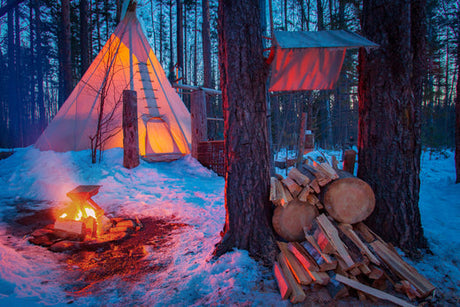According to a recent outdoor recreation survey, hand-held saws like a folding saw rank among the top three most valuable tools for wilderness enthusiasts. I’ve definitely felt the difference a reliable folding saw can make—especially when I’m miles away from civilization! Let’s walk through How to choose the right one, mastering cutting techniques, and keeping it in top condition.
Table of Contents
Why a Folding Saw Is Essential for Survival
A folding saw is one the most critical cutting tool in your survival kits. I’ve seen firsthand how a reliable saw can make life much easier—whether you’re setting up camp, gathering firewood, or constructing an emergency shelter. I'd personally Choose a folding saw over something larger and more powerful options like a chain saw when I'm trail clearing in the wild.
Why a Hand Saw vs a Chain-saw
A heavy-duty chain saw can seem like a powerful choice for cutting wood. However, it’s not always practical in backcountry settings. Weight, fuel needs, and maintenance all become major drawbacks. Here are some key reasons I choose to bring a compact saw for clearing or trimming brush while hiking.
- Portability: Slips easily into your backpack with little extra weight
- Lower Maintenance: No need to carry oil or gas, and fewer mechanical parts
- Ease of Use: Designed for quick manual operation with minimal fuss
Even though gas or electric saws can clear large areas fast, the convenience of a folding saw often wins out in remote environments.
Choosing the Right Type of Saw
There is no perfect saw but popular brands like silky and fiskars offer different features that cater to various tasks. Some saws have a straight blade, while others have slight curve so they can grip wood securely. When choosing, pay attention to these saw features:
- Blade Length: Longer saw blades handle bigger branches but might be less compact
- Blade Material: Steel blades typically offer greater durability and rust resistance.
- Blade Design: Curved blades help maintain contact with the wood, improving cutting efficiency and control
-
Tooth Pattern: Coarse teeth cut faster, while fine teeth can be more precise
Handle Design: Rubber or contoured grips help prevent slippage and fatigue - Safety Lock Mechanisms: Locks the blade in place, preventing accidents when opened or closed
When picking a folding saw, consider where you’ll use it most—backyard spring cleaning or trekking through the wilderness—and choose a model that meets those needs.
Key Features to Look For: blade curve, large teeth, and a locking blade
Your goal is to find a saw that’s versatile enough to handle different tasks. Look for a blade with a slight curve for better bite, especially if you’re cutting overhead or at awkward angles. Large teeth can reduce sawing time by biting into the wood more aggressively. Meanwhile, a sturdier locking mechanism helps keep the blade secure, reducing the risk of accidents. Having a stable pivot point means you can apply pressure without worrying about it folding mid-cut.
Two models from Silky Saw in my opinion stand out amongst the rest: the Katanaboy 650 and the Bigboy Outback. The Katanaboy 650 is quite large, yet it's renowned for its unrivaled cutting capacity—ideal for hefty branches or small logs. Meanwhile, the Outback is easy to carry and celebrated for its durability, making it a dependable choice for trail trips. I've personally tested and reviewed both these saws and whether you need to remove brush to make a flat spot for your tent or tidy up your campsite, these saws have you covered! I've include my video reviewing the Silky Saw Katanaboy 1000 Below
Why a compact pruning saw Belongs in Your Bag while Backpacking
Many hikers carry a pruning saw because it’s light enough to carry yet strong enough to cut away branches and small saplings. If a storm hits and you need to build a makeshift shelter, you’ll be glad you packed one. From tidying up campsites to collecting firewood, it has multiple purposes and is simple to store. Slip it into your bag, and you’ll have peace of mind knowing you can handle sudden challenges along the trail.
In the end, a good survival tool is an investment in your safety and comfort. Whether you’re hiking through remote wilderness or spending a few nights in a favorite campground, having a dependable saw ensures you’re prepared to tackle tasks—both big and small—whenever the situation calls for it.
Proper Techniques for Cutting
Cutting wood in the wild isn’t just about brute force. In my experience, using the right technique can mean the difference between a quick, clean cut and a jagged, time-consuming struggle. I’ve learned to use different methods along for different blade styles—whether you’re using a pocketboy, a bigboy, or a Katana Boy. They all use the same principals but require their own methods
Mastering Your Grip and Stance

A comfortable grip is key for safe, efficient work—especially when handling a saw with large teeth. I’ve seen campers rush into cutting without thinking about their body position, which often leads to fatigue and uneven cuts. Here’s what helps me:
- Align Your Body: Keep your hand and forearm in a straight line with the saw so the motion stays consistent.
- Bend Your Knees: A slight bend stabilizes your center of gravity and helps absorb any sudden pressure changes.
- Firm Yet Flexible Grip: Grab the handle firmly but allow for a bit of give so you can adjust your angle if the wood has a curve or knot.
Matching the Right Saw to the Job
When I’m backpacking, I tend to favor a lightweight option like the Outback, as they’re both
Setting the Right Pace
I’ve learned over the years that trying to power through a log with quick, forceful strokes can actually work against you. A steady “back and forth” motion allows the saw to do the heavy lifting:
This method works equally well for a bigboy or a standard folding saw, and it’ll spare your arms in the long run.
Making Each Stroke Count
Roughly 60% of cutting efficiency can come from the pull stroke, especially with saws that are designed to cut primarily on the pull. If you notice the fold bending or the curve snagging, try adjusting the angle slightly:
Keeping It Versatile for camp and Beyond
One of my favorite things about a good folding saw is its multipurpose nature. Whether you’re creating a space to pitch your tent or crafting a makeshift shelf, having a reliable saw on hand is crucial. They help me cut away branches quickly, and their compact design fits neatly in my backpack. For tougher jobs, a more rugged option, such as the Katanaboy, can tackle denser wood or larger logs without much fuss.
The bottom line is this: Proper cutting techniques don’t just save energy—they also keep you safer. By choosing the right saw, standing correctly, and moving in a controlled rhythm, you’ll make quick work of any branch or log you encounter. That’s how I manage to handle everything from basic camp chores to urgent cutting tasks with confidence!
Maintenance & Care
Regular upkeep doesn’t just keep your tools looking pristine—it also extends its lifespan and boosts performance. I’ve had a Silky Outback that has lasted well beyond its expected lifespan simply by sticking to these maintenance steps. Below, I’ll break down the essentials of proper cleaning, lubrication, sharpening, and storage—along with some quick bullet points that add real value.
Regular Cleaning
Wiping down your blade after every use is critical. From Pocketboy to Kantanaboy, any saw can accumulate sap, sawdust, and moisture that might cause rust.
- Use a Soft Brush or Cloth: This gently removes debris from the teeth without scratching the metal.
- Spot-Clean with Soap and Water: If the saw is heavily soiled, mild soapy water loosens tough dirt or sap. Just remember to dry everything thoroughly afterward.
- Inspect the Pivot Area: Gently remove trapped particles around the hinge to keep the fold mechanism smooth.
I’ve noticed that large-tooth saws, like the Katanaboy, hold onto debris more easily—so be extra thorough if you’re using one of these.
Lubrication
A thin layer of oil on the blade and pivot point reduces friction and guards against rust, especially in humid or rainy conditions.
- Use Light Machine Oil or Silicone Spray: Apply a few drops to the pivot area, then work the saw open and closed to spread it evenly.
- Wipe Off Excess: Too much lubricant can attract dirt and sawdust. A quick rub with a cloth removes any surplus.
- Reapply as Needed: If you’re on an extended camping trip, give your saw a fresh coat every couple of days—or anytime you notice sticking.
If I’m on a long bushcraft adventure, I pack a small squeeze bottle of oil to quickly address squeaks or signs of rust.
Blade Sharpening
A dull blade forces you to use extra effort, which could lead to jagged cuts or even dangerous kickbacks.
- Check Tooth Condition Frequently: Examine the teeth after each day’s use. If they look rounded or feel dull, it’s time to sharpen.
- Use a Proper File: A specialized saw file matches the shape of your saw’s tooth pattern.
- Replace Severely Worn Blades: Some models, like the pocketboy allow for quick blade swaps. This can be a lifesaver in the wild if you don’t have the tools or time to sharpen.
I’ve found that with heavier-duty saws like the Katana Boy, you might prefer swapping in a fresh blade when the teeth wear down, especially if you’re cutting tough wood frequently.
Safe Storage
Safeguarding your folding saw after each use helps it stay ready for the next adventure.
- Fold and Lock: Always ensure the blade is fully folded with its locking mechanism engaged to avoid accidental openings in your backpack.
- Store in a Dry Place: Moisture leads to rust, so keep your saw in a sealed container or pouch when you’re not using it.
- Avoid Extreme Temperatures: High heat can warp plastic handles or rubber grips, while freezing temps may impact metal components.
A well-maintained saw can tackle tasks ranging from campsite chores to heavy-duty woodcutting. By integrating these maintenance habits into your routine, you’ll preserve both the performance and longevity of any saw in your kit.
Safety Best Practices
Staying safe with any folding saw is just as important as finding the right one. Here are a few tips I’ve picked up that can help keep you and those around you out of harm’s way. Last thing you need in the bush is to use your trauma kit!
Protective Gear
- Gloves: A sturdy pair of gloves safeguards your hand against unexpected slippage, especially if you’re working with a pruning saw or any model that has large teeth.
- Eye Protection: Wood chips can fly off at surprising angles, especially if the curve of the blade binds. Goggles or safety glasses are a simple way to protect your vision.
- Long Sleeves and Pants: If you’re prepping a space for a new camp area or trimming brush, fabric layers can help reduce scratches or minor cuts.
Tip: Keep a lightweight gear pouch in your backpack with gloves, protective eyewear, and basic first aid supplies—especially if you’re backpacking long distances.
Prepare The Area for Cutting
Before you start sawing, look around. Remove obstacles that might cause you to trip or get tangled:
- Debris-Free Zone: Rocks, branches, and loose foliage can create hazards. Clear them to avoid accidents.
- 360° Awareness: Remember, a folding saw can be almost as dangerous as a chain saw if misused, so maintain awareness of your surroundings.
In tight spaces, consider a smaller, more compact option like a pocketboy or gomboy for safer maneuverability.
Proper Body Position
- Stable Stance: Plant your feet shoulder-width apart to stay balanced. If the blade gets stuck, you don’t want to topple.
- Angle of Attack: Avoid cutting directly toward yourself or others. If you need to adjust for a better line, pivot your body instead of twisting the blade.
- Smooth Motions: Let the tooth design do the work. Jerky pushes or pulls can cause slips, especially on slick surfaces.
Practice first on smaller branches to get used to the motion—this helps build confidence in your technique.
Communication
If you’re working with friends or family, a quick chat beforehand can prevent close calls:
- Cutting Plan: Let people know where you’re about to start cutting and in which direction debris might fall.
- Safe Distance: Keep others at least an arm’s length away (or more) when using a Katana Boy, or any other larger folding saw.
Open communication makes for an efficient, coordinated effort—ideal for multi-person chores like setting up a big camp or dealing with storm damage.
By following these precautions, you’ll stay safer while enjoying the versatile benefits of your folding saw—no matter if it’s a silky, ka-bar folding saw, or another trusted model.
Final Thoughts
A reliable folding saw is more than just another tool in your kit—it’s a genuine game-changer for anyone seeking a self-reliant lifestyle or gearing up for the next wilderness adventure. From mastering your cutting technique to choosing the right model—be it a Silky Katana Boy, Bigboy Outback, or something more compact—every detail plays a role in making your outdoor experience smoother and safer. In my time out in the backcountry, I’ve seen how the right saw can simplify tasks, conserve energy, and even prevent emergencies. Ready to put these insights into practice? Buy a folding saw that suits your needs, stay mindful of safety, and venture forward with confidence!










